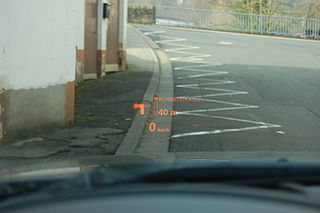
Attention or focus, is the concentration of awareness on some phenomenon to the exclusion of other stimuli. It is the selective concentration on discrete information, either subjectively or objectively. William James (1890) wrote that "Attention is the taking possession by the mind, in clear and vivid form, of one out of what seem several simultaneously possible objects or trains of thought. Focalization, concentration, of consciousness are of its essence." Attention has also been described as the allocation of limited cognitive processing resources. Attention is manifested by an attentional bottleneck, in terms of the amount of data the brain can process each second; for example, in human vision, less than 1% of the visual input data stream of 1MByte/sec can enter the bottleneck, leading to inattentional blindness.
Information overload is the difficulty in understanding an issue and effectively making decisions when one has too much information (TMI) about that issue, and is generally associated with the excessive quantity of daily information. The term "information overload" was first used as early as 1962 by scholars in management and information studies, including in Bertram Gross' 1964 book, The Managing of Organizations, and was further popularized by Alvin Toffler in his bestselling 1970 book Future Shock. Speier et al. (1999) said that if input exceeds the processing capacity, information overload occurs, which is likely to reduce the quality of the decisions.

Flow in positive psychology, also known colloquially as being inthe zone, is the mental state in which a person performing some activity is fully immersed in a feeling of energized focus, full involvement, and enjoyment in the process of the activity. In essence, flow is characterized by the complete absorption in what one does, and a resulting transformation in one's sense of time. Flow is the melting together of action and consciousness; the state of finding a balance between a skill and how challenging that task is. It requires a high level of concentration. Flow is used as a coping skill for stress and anxiety when productively pursuing a form of leisure that matches one's skill set.
Distraction is the process of diverting the attention of an individual or group from a desired area of focus and thereby blocking or diminishing the reception of desired information. Distraction is caused by: the lack of ability to pay attention; lack of interest in the object of attention; or the great intensity, novelty or attractiveness of something other than the object of attention. Distractions come from both external sources, and internal sources. External distractions include factors such as visual triggers, social interactions, music, text messages, and phone calls. There are also internal distractions such as hunger, fatigue, illness, worrying, and daydreaming. Both external and internal distractions contribute to the interference of focus.

Media multitasking is the concurrent use of multiple digital media streams. Media multitasking has been associated with depressive symptoms and social anxiety by a study involving 318 participants. A 2018 review found that while the literature is sparse and inconclusive, people who do a heavy amount of media multitasking have worse performance in several cognitive domains. One of the authors commented that while the data does not "unambiguously show that media multitasking causes a change in attention and memory," media multitasking is an inefficient practice that requires "task switching" costs including "limitations in auditory and visual processing".
Linda Stone, a tech writer and consultant, coined the term continuous partial attention in 1998 to describe a modern adaptive behavior of continuously dividing one's attention. Stone has clarified that continuous partial attention is not the same as multitasking. Where multitasking is driven by a conscious desire to be productive and efficient, CPA is an automatic process motivated only by "a desire to be a live node on the network" or by the willingness to connect and stay connected, scanning and optimizing opportunities, activities and contacts in an effort to not miss anything that is going on.
Mindfulness-based cognitive therapy (MBCT) is an approach to psychotherapy that uses cognitive behavioral therapy (CBT) methods in conjunction with mindfulness meditative practices and similar psychological strategies. The origins to its conception and creation can be traced back to the traditional approaches from East Asian formative and functional medicine, philosophy and spirituality, birthed from the basic underlying tenets from classical Taoist, Buddhist and Traditional Chinese medical texts, doctrine and teachings.
In the field of psychology, absent-mindedness is a mental state wherein a person is forgetfully inattentive. It is the opposite mental state of mindfulness.

The psychological and physiological effects of meditation have been studied. In recent years, studies of meditation have increasingly involved the use of modern instruments, such as fMRI and EEG, which are able to observe brain physiology and neural activity in living subjects, either during the act of meditation itself or before and after meditation. Correlations can thus be established between meditative practices and brain structure or function.
In psychology, self-compassion is extending compassion to one's self in instances of perceived inadequacy, failure, or general suffering. American psychologist Kristin Neff has defined self-compassion as being composed of three main elements – self-kindness, common humanity, and mindfulness.

Human multitasking is the concept that one can split their attention on more than one task or activity at the same time, such as speaking on the phone while driving a car.
Interruption science is the interdisciplinary scientific study concerned with how interruptions affect human performance, and the development of interventions to ameliorate the disruption caused by interruptions. Interruption science is a branch of human factors psychology and emerged from human–computer interaction and cognitive psychology.

Attentional control, colloquially referred to as concentration, refers to an individual's capacity to choose what they pay attention to and what they ignore. It is also known as endogenous attention or executive attention. In lay terms, attentional control can be described as an individual's ability to concentrate. Primarily mediated by the frontal areas of the brain including the anterior cingulate cortex, attentional control and attentional shifting are thought to be closely related to other executive functions such as working memory.
Multi-communicating is the act of managing multiple conversations simultaneously. The term was coined by Reinsch, Turner, and Tinsley, who proposed that simultaneous conversations can be conducted using an array of media, including face-to-face, phone, and email tools for communication. The practice allows individuals to utilize two or more technologies to interact with each other.

Ergonomics, also known as human factors or human factors engineering (HFE), is the application of psychological and physiological principles to the engineering and design of products, processes, and systems. Primary goals of human factors engineering are to reduce human error, increase productivity and system availability, and enhance safety, health and comfort with a specific focus on the interaction between the human and equipment.

Mindfulness has been defined in modern psychological terms as "paying attention to relevant aspects of experience in a nonjudgmental manner", and maintaining attention on present moment experience with an attitude of openness and acceptance. Meditation is a platform used to achieve mindfulness. Both practices, mindfulness and meditation, have been "directly inspired from the Buddhist tradition" and have been widely promoted by Jon Kabat-Zinn. Mindfulness meditation has been shown to have a positive impact on several psychiatric problems such as depression and therefore has formed the basis of mindfulness programs such as mindfulness-based cognitive therapy, mindfulness-based stress reduction and mindfulness-based pain management. The applications of mindfulness meditation are well established, however the mechanisms that underlie this practice are yet to be fully understood. Many tests and studies on soldiers with PTSD have shown tremendous positive results in decreasing stress levels and being able to cope with problems of the past, paving the way for more tests and studies to normalize and accept mindful based meditation and research, not only for soldiers with PTSD, but numerous mental inabilities or disabilities.

An automotive head-up display or automotive heads-up display — also known as an auto-HUD — is any transparent display that presents data in the automobile without requiring users to look away from their usual viewpoints. The origin of the name stems from a pilot being able to view information with the head positioned "up" and looking forward, instead of angled down looking at lower instruments. At this time, there are three different approaches to OEM HUDs in automobiles. The first is to treat the back of the windshield in such a way that an image projected onto it will reflect to the driver. The second is to have a small combiner that is separate from the windshield. Combiners can be retracted. The third is to laminate a transparent display in between layers of the windshield glass.
Mindfulness and technology is a movement in research and design, that encourages the user to become aware of the present moment, rather than losing oneself in a technological device. This field encompasses multidisciplinary participation between design, psychology, computer science, and religion. Mindfulness stems from Buddhist meditation practices and refers to the awareness that arises through paying attention on purpose in the present moment, and in a non-judgmental mindset. In the field of Human-Computer Interaction, research is being done on Techno-spirituality — the study of how technology can facilitate feelings of awe, wonder, transcendence, and mindfulness and on Slow design, which facilitates self-reflection. The excessive use of personal devices, such as smartphones and laptops, can lead to the deterioration of mental and physical health. This area focuses on redesigning and creating technology to improve the wellbeing of its users.
Embodied writing practices are used by academics and artists to highlight the connection between writing and the body, bring consciousness to the cultural implications of academic writing, and inform an understanding of art forms as first person narrative. Embodied writing practices serve as a means to transcend the traditional boundaries of language and communication, inviting individuals to explore the intricate relationship between their physical experiences and the act of writing itself.
The 52/17 Rule is a time management method that recommends 52 minutes of focused working followed by 17 minutes of complete resting and recharging.








